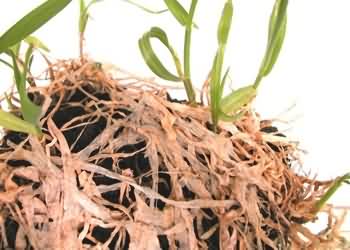Diseases
Microdochium nivale (Fr.) Samuels and I.C. Hallett (Fusarium nivale Ces. ex Berl. and Voglino) - Rye Pink Snow Mold.
Systematic position.
Anamorph - Microdochium nivale (Fr.) Samuels and I.C. Hallett. Class Deuteromycetes, Order Tuberculariopsis, Family Tuberculariacea, Genus Microdochium. Teleomorph - Monographella nivalis (Schaffnit) E. Muller = Calonectria graminicola (Berk et Br.) Wollenw. (Syn.: C.nivalis, Griphosphaeria nivalis, Micronectriella nivalis). Class Ascomycetes, Subclass Euascomycetidae, Order Hypocreales, Family Nectriaceae, Genus Monographella (Hawksworth et al., 1995).Biological group.
Hemibiotroph.Morphology and biology.
The fungus infects winter grain crops, i.e., rye and wheat, and also species of Agrostis, Alopecurus, Cynodon, Dactylis, Festuca, Lollium, Poa. The disease is shown in the early spring, right after snow thawing. On the leaves its symptoms appear as small circular watery discolored spots. The mycelium growth may also be visible on patches near edge of receding snow. Under close examination, pink colored sporodochia (i.e., mass of united conidiophores) are visible in rows on leaf blades. Under favorable for the disease development conditions the fungus may kill the crowns, leaf sheaths, and roots, and plants withering is observed. Conidia of fungus may be formed at the base of stems and on the rests of lost plants during the whole vegetative period. Conidia are fusiform, sickle-shaped, hyaline (pink in mass), 14-25 x 3-4 .. Perithecia are conic to globular, brick-red. Asci are clavate, thin-walled, 50-70 x 8-10 ., with 6 to 8 ascospores in each one. Mature ascospores are ellipsoid, straight or curved, hyaline, with 1 to 3 septa. The fungus survives warm and dry weather as dormant fungal mycelium or as dormant spores in soil and on plant residues. Spores germinate in cool wet conditions, producing hyphae that infect grass leaves.Distribution.
The Snow Mould is distributed in the temperate zone of America and Eurasia in regions with long period of snow cover. In Russia the disease has wide distribution in areas of winter grain crops cultivation. On rye it occurs in all regions of rye cultivation, mainly in North-western, Central, and Volgo-Vyatka regions.Ecology.
Spores germination and fungus development may be realized under snow at temperature 0-5.C, while other plant pathogen fungi are not capable to grow; the temperature higher than 25.C suppresses its development. Strong disease develops only on the plants weakened by long (more than 110 days) stay under snow at the temperatures near 0.C, especially when snow drops on unfrozen soil. Conidia germination is carried out at relative humidity more than 95%, and spores formation is at 85-95%. Snowy winters, high soil humidity, long snow thawing, and increased soil acidity raise danger of Snow Mould development.Economic significance.
For the long-term period the death of plants caused by the Snow Mould reaches 10% on the average. Re-seeding of winter crops is necessary after destruction of more than 50% of plants that occurs one time for 10 years in Northwest region. Re-seeding of at most 10% of the crops is necessary after destruction of 30% of plants and less (2 times in 10 years). Protective actions: use of resistant and tolerant varieties, crop rotation and optimal sowing terms, treatment of seeds and plants by fungicides (fundazole, roxil and others).Related references:
Andreeva E.I., Molchanov O. Yu. 1987. Snow mould of winter grain-crops. M.NIITEHIM. 45 p. (in Russian)Hawksworth D.L., P.M. Kirk, eds. 1995. Ainsworth and Bisby's Dictionary of the fungi. CAB Intern.: 616 p.
Ishkova T. I., Berestetskaya L. I., Gasich E. L., Levitin M. M. & Vlasov D. Yu. 2002. Diagnostics of the main fungal diseases of cereal crops. St. Petersburg: VIZR. 76 p. (in Russian)
Kuperman F.M., Moiseichik V.A. 1977. Bushing of winter crops. Leningrad: Gidrometeoizdat. 168 p. (in Russian)
Nazarova L. N., Dymchenko A. M., Polyakova T. M., Zhokhova T.P. 2000. System of winter rye protection from snow mould. Agro XXI 7: 2-3 (in Russian)
Sidorova S. F. 1971. Snow mould of winter crops. A technique of the territorial long-term forecasting of plant diseases. Leningrad: VIZR. p. 48-49 (in Russian)
© Dmitriev A.P.


